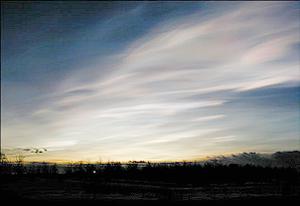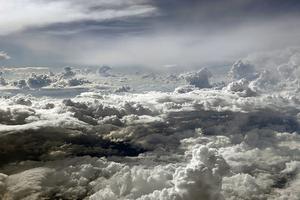Climate Change Complicates Ozone Recovery
BALTIMORE, Maryland, April 10, 2009 (ENS) - Increasing greenhouse gases would delay or even postpone the recovery of ozone levels in the lower stratosphere over some parts of the planet, according to new research by scientists from NASA and Johns Hopkins University.
Earth's ozone layer is predicted to recover from the destruction caused by the use of refrigerants and other ozone-depleting chemicals in the 20th century. But the studies find that the ozone layer of the future will be different from the ozone layer of the past because greenhouse gases are changing the dynamics of the atmosphere.
While the buildup of greenhouse gases warms the atmosphere from Earth's surface up six miles high, it cools the upper stratosphere – the atmospheric layer between 18 and 31 miles up.
This cooling slows the chemical reactions that deplete ozone in the upper stratosphere and allows natural ozone production there to outpace destruction by refrigerants and other ozone depleters.
But the accumulation of greenhouse gases also changes the circulation of stratospheric air masses from the tropics to the poles, NASA scientists explain.
In Earth's middle latitudes, that means ozone is likely to "over-recover," the scientists said, growing to concentrations higher than it was before the mass production of chlorofluorocarbons, halons, carbon tetrachloride, methyl chloroform and hydrochlorofluorocarbons destroyed it.
 |
Stratospheric clouds over Sweden (Photo by Lamont Poole, NASA Langley Research Center) |
In the tropics, stratospheric circulation changes could prevent the ozone layer from fully recovering.
"Most studies of ozone and global change have focused on cooling in the upper stratosphere," said Feng Li, an atmospheric scientist at the Goddard Earth Sciences and Technology Center at the University of Maryland Baltimore County, Baltimore, Maryland and lead author of the study. "But we find circulation is just as important. It's not one process or the other, but both."
The findings are based on a detailed computer model that includes atmospheric chemical effects, wind changes, and solar radiation changes.
Li's experiment is part of an ongoing international effort organized by the United Nations Environment Programme's Scientific Assessment Panel to assess the state of the ozone layer. Li and colleagues published their analysis in March in the journal "Atmospheric Chemistry and Physics."
Working with Richard Stolarski and Paul Newman of NASA's Goddard Space Flight Center in Greenbelt, Maryland, Li adapted the Goddard Earth Observing System Chemistry-Climate Model to examine how climate change will affect ozone recovery.
The team inserted past measurements and future projections of ozone-depleting substances and greenhouse gases into the model. Then the model projected how ozone, the overall chemistry, and the dynamics of the stratosphere would change through the year 2100.
"In the real world, we have observed statistically significant turnaround in ozone depletion, which can be attributed to the banning of ozone-depleting substances," said Richard Stolarski, an atmospheric chemist at Goddard and a co-author of the study. "But making that connection is complicated by the response of ozone to greenhouse gases."
The researchers found that greenhouse gases alter a natural circulation pattern that influences ozone distribution.
Circulation is like a pump to the stratosphere, moving ozone from the lower parts of the atmosphere, into the upper stratosphere over the tropics. Air masses then flow north or south through the stratosphere, away from the tropics toward the poles.
 |
Clouds in the troposphere (Photo by Polpolux) |
In Li's experiment, this circulation pump accelerated to a rate where the ozone flowing upward and outward from the tropics created a surplus at middle latitudes.
Though the concentration of chlorine and other ozone-depleting substances in the stratosphere will not return to pre-1980 levels until 2060, the ozone layer over middle latitudes recovered to pre-1980 levels by 2025.
The Arctic, which is better connected to mid-latitude air masses than the Antarctic, benefitted from the surplus in the northern hemisphere and from the overall decline of ozone-depleting substances to recover by 2025.
Globally averaged ozone and Antarctic concentrations catch up by 2040, as natural atmospheric production of ozone resumes.
This recovery in the middle and polar latitudes has mixed consequences, Li noted. It might have some benefits, such as lower levels of ultraviolet radiation reaching the Earth's surface and correspondingly lower rates of skin cancer.
On the other hand, he said, it could have unintended effects, such as increasing ozone levels at Earth's surface.
The model also shows a continuing ozone deficit in the stratosphere over the tropics. When the model run ended at year 2100, the ozone layer over the tropics still showed no signs of recovery.
In February, researchers from Johns Hopkins University in Baltimore, teamed with Stolarski and other NASA scientists on a similar paper suggesting that increasing greenhouse gases could delay the recovery of ozone levels in the lower stratosphere over some parts of the globe.
Using the same model as Li, Stolarski, and Newman, the researchers found that the lower stratosphere over tropical and mid-southern latitudes might not return to pre-1980s levels of ozone for more than a century, if ever.
Copyright Environment News Service (ENS) 2009. All rights reserved.
To subscribe or visit go to: http://www.ens-newswire.com